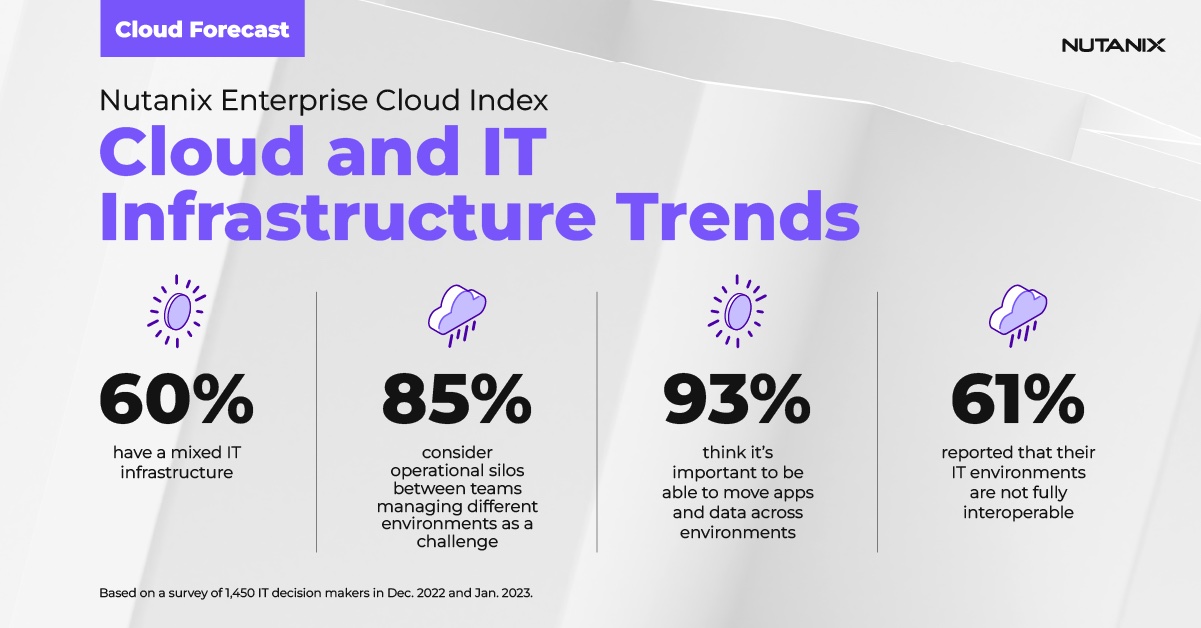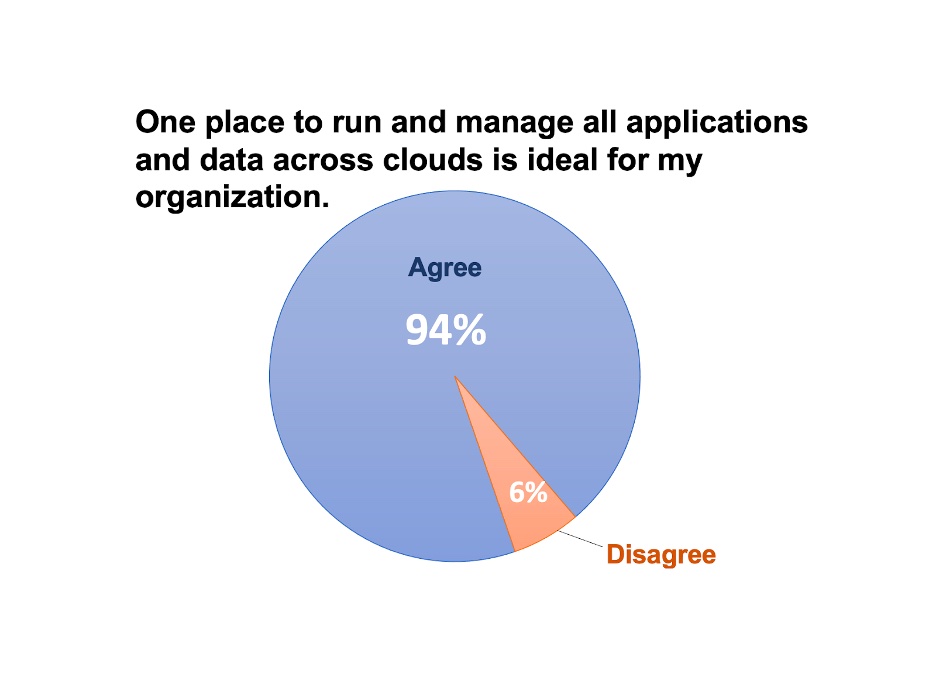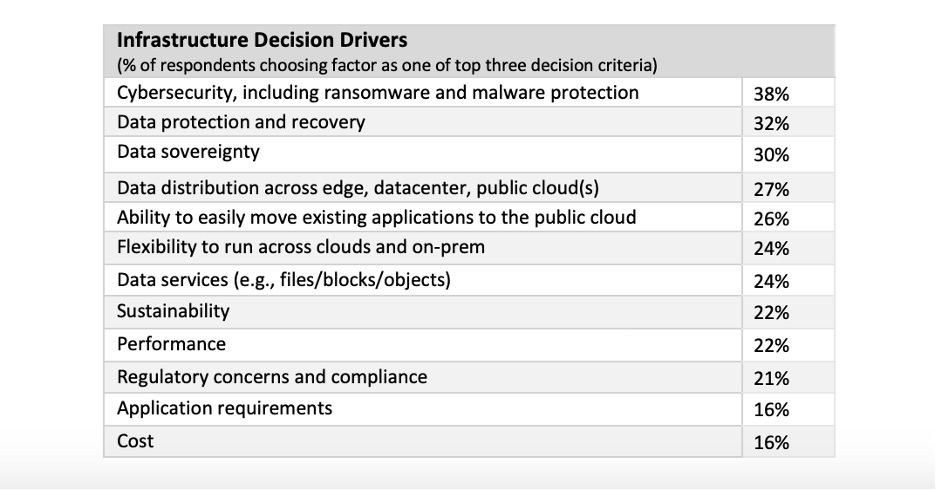There’s a surge in mixed IT environments and an escalating demand for unified management tools, according to 2023 Enterprise Cloud Index (ECI). The latest findings from Nutanix’s fifth annual survey reflect many macro and technology factors that have created an IT industry in transition.
“What this year’s ECI [study] shows and what we’re hearing from customers is that there’s a need in the market for a cloud operating model to help build, operate, use, and govern a hybrid multicloud to support all types of applications – starting today and planning for tomorrow,” said Lee Caswell, SVP of product and solutions marketing at Nutanix.
When ECI research was first conducted in 2018, the majority of global enterprise IT professionals surveyed (57%) envisioned one day running all their workloads exclusively in a private cloud or a single public cloud platform. Fast-forward to today, however, and the tide has turned.
In a post-pandemic economy where geopolitical and sustainability issues are influencing business decisions from the board room to the shop floor, 60% of the survey base now reports actively operating more than one IT environment. Nearly a quarter (23%) use third-party hosted data centers in addition to on-premises private data center environments, for example. A third (33%) run a mix of private and public clouds, while 4% exclusively rely on multiple public clouds to meet all their IT infrastructure needs.

ECI data indicates that mixed-infrastructure usage will reach nearly three-quarters (74%) of global enterprises within three years. Moreover, nearly all (99%) of the 1,450 organizations involved in the 5th Annual study moved applications to a different infrastructure in the past year; the reasons ranged from improving security posture to controlling IT costs.
Managing IT Risk
Findings indicate that enterprises increasingly want to leverage different benefits inherent in private and public clouds. Amid supply chain challenges, for example, those using both private and third-party hosted or public cloud environments can turn to services that help them scale to meet changing needs.
In addition, many organizations seek access to outside talent and other IT resources, as evidenced by the 41% of respondents who reported that outsourcing IT management played a role in their decisions to move applications last year. Outsourcing was the reason mentioned second most often for moving applications, following security (43%).
Mixed infrastructures create new management challenges, though, and 94% of this year’s respondents agreed that a single, unified place to manage applications and data across their diverse environments would be ideal for their organizations. Cost and risk mitigation are driving this sentiment, according to Induprakas Keri, senior vice president of Nutanix cloud infrastructure and Nutanix Cloud Clusters.

“Having to develop expertise with multiple cloud providers is time-consuming and expensive, and different cloud providers are at different levels of maturity,” he said. “From a risk-mitigation perspective, customers want the ability to deal with change, security issues, and cloud outages with minimal disruption. If workloads are managed at different sites or by separate teams, you lose overall control. More importantly, the coordination needed to deal with holistic security and disaster-recovery issues is far greater and more error-prone.”
The Crux of Management Struggles
It’s one thing to distribute IT workloads across multiple places. But segmenting people and processes to manage them is less than ideal. Enterprises are learning that optimizing a mixed infrastructure relies on deploying underlying hybrid operations, which requires consistent processes and tools for managing the pockets of IT as a unified whole.
This has been easier said than done, said Keri, traditionally requiring IT shops to write their own operational code. The reason is that the available public cloud platforms are fundamentally different, he said.
“Unlike the days of the server battles when all the different Unix versions were mostly similar, Microsoft Azure, Amazon Web Services, and Google Cloud Platform are very different, from different hypervisors to different bare metal offerings and overlay networking,” he said.
Creating operational code that works across cloud platforms has required expertise in disparate platforms that can be hard to come by on any given enterprise IT team, he said.
“The other big problem is the traditional tension between developers and IT,” Keri continued.
“The entry point to cloud is for developers, but developers have a very different point of view about risk, security, and operations than IT does. Developers and IT need to work together, and this doesn’t always happen easily.”
Infrastructure becomes a contentious issue.
“Enterprises continue to run legacy applications that can’t be modernized at the drop of a hat,” he said. “While the cloud makes perfect sense for net-new applications, often the value of these applications is fully realized only when they integrate with on-premises apps.”
He said enterprises in this situation find themselves in need of tools that ease such integration tasks.
Protecting and Managing Data Is Paramount
Data security, protection/recovery, and sovereignty continue to top the list of key infrastructure decision drivers among ECI companies. Sustainability and cost fell surprisingly low on respondent priority lists. For example, while 92% said sustainability is more important to their organizations today than it was a year ago, as a decision criterion, it ranks seventh, tying with performance among global respondents asked to choose their three biggest decision drivers. What’s more, 85% of respondents agree that meeting corporate sustainability goals is a challenge, and more than a third (36%) describe it as a “significant” one.

Survey findings showed that respondents are similarly fickle when it comes to cost issues. As a driver of choosing infrastructure, cost fell dead last, with just 16% of respondents saying it was a top-three decision criterion. At the same time, 85% said they consider cloud cost control a challenge, nearly a third (30%) said they were “very concerned” about cloud costs in relation to their IT budgets in the coming year, and another 46% said they were “somewhat concerned.”
The seeming disparity could have to do with the many dimensions of IT total cost of ownership (TCO). Determining the cost factors to control to make the biggest spending impact can be difficult, particularly as organizations struggle to decide whether cloud is a consumption model or an operating model. For example, if cloud is viewed as a consumption choice, IT teams can choose the least expensive place to run a given workload.
At the same time, though, it could take multiple years to rewrite applications to run in the less expensive infrastructure, he said, which could ultimately be more expensive than paying more in recurring operating costs, at least for some time period. Similarly, sustainability is a simple word with many dimensions and implications, all of which may not be readily apparent when creating an IT infrastructure priority checklist.
Ultimately, the increased emergence of hybrid tools that use cloud abstraction and overlay technologies, including low-code tools for IT generalists, will ease the enterprise task of blending and optimizing infrastructure operations. Whether IT shops build them or buy them, these tools are enablers of simpler, faster application migration and mobility and the means to achieving end-to-end mixed-infrastructure visibility, interoperability, security, and management—all from a common, unified place.
Editor’s note: The 5th Annual Enterprise Cloud Index (ECI) report is the result of a global research study conducted by U.K.-based Vanson Bourne and commissioned by Nutanix. In December 2022 and January 2023, the researcher surveyed 1,450 global IT decision-makers about their IT and cloud deployment priorities, challenges, and plans.
Joanie Wexler is a contributing writer and editor with more than 25 years of experience covering the business implications of IT and computer networking technologies.
© 2023 Nutanix, Inc. All rights reserved. For additional legal information, please go here.




